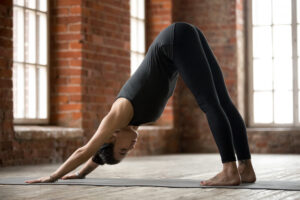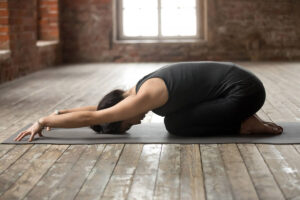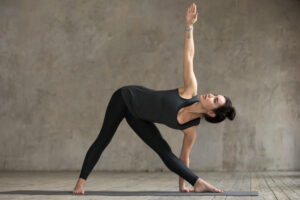There is a common misconception in yoga practice that yoga blocks and yoga bolsters are for beginners or those practising Iyengar yoga. More experienced yogis become convinced that they don’t need blocks and give them a wide berth, seeing them akin to stabilisers on a toddler bicycle. However, everyone can enhance their yoga practice using these key pieces of equipment, so we will look at how they can support the less supple and deepen the practice of the more flexible yogini or yogi.

Choosing Yoga Blocks
We are focusing on yoga blocks which tend to be rectangular in shape and made of either cork or foam. Foam yoga blocks are not as stable but generally a little easier on the joints. The cork block is the more stable option if you are using yoga blocks in weight-bearing positions. It’s a good idea to have both on hand as you expand your practice, but if you are just starting and don’t want to spend loads of money, go for the foam yoga block first. Yoga blocks are normally sold in pairs, and you want to make sure you have two, as most exercises require them.
Read on to see how yoga blocks can be used in some of our favourite yoga positions!
Downward Facing Dog (Adho Mukha Svanasana)
New Yogis Accessibility:
Downward Facing Dog is a great yoga pose but requires more upper body strength than you might realise.

If you are new to yoga, this can be quite challenging, and you can aid your practice by placing one block under each hand. Ensure they are placed lengthways, the same as the mat and spread your hand flat and wide across the block. This addition, in height at the front, takes some of the pressure away from your hands and wrists, shifting it back to the heels.
It’s also important to allow your head to hang below the heart.
Experienced Yogis Challenge:
If Downward Facing Dog is no problem at all, you can challenge your body further by placing your blocks lengthways towards the back of your mat and putting one foot on each, throwing your weight towards the front of the body. Keep your feet flat and your heels down, and you will notice an increase in the stretch along the backs of your legs, down through your shoulders and into your arms and hands.
Child’s Pose (Balasana)
New Yogis Accessibility:
Child’s Pose is perfect for the end of practice, creating a restful environment. 
Experienced Yogis Challenge:
Have your yoga blocks lengthways in front of you. Allow your back end to sink into the Child’s Pose and rest your bottom towards your heels. Place your elbows on the blocks with your hands bent back up to your shoulders. This opens the chest and stretches your arms and shoulders.
Bridge Pose (Setu Bandhasana)
New Yogis Accessibility:
The Bridge pose is designed to create strength in the back and core of the body. It can be a restful, restorative pose. 
Experienced Yogis Challenge:
Yoga blocks can be used in two different ways when it comes to enhancing the Bridge Pose for an experienced yogi. Firstly, you can place your yoga block in a comfortable position under your sacrum and then find your balance and lift one leg straight up into the air. You can then deepen your stretch by bringing the knee into the chest. Finally, switch sides for an even workout.
Before lifting your bottom off the ground, place the block between your knees, and then, as you lift and engage your core muscles, you will be working harder to raise the hips off the ground as your legs must work together to keep the yoga block in place.
Triangle Pose (Utthita Trikonasana)
Triangle Pose New Yogis Accessibility:
The triangle pose has many benefits, but it can be hard to achieve as it requires a level of balance.
Experienced Yogis Challenge:
Stand with your yoga block between the palms of your hands lengthways. Reach up tall and then lean to the side for an unsupported version of the triangle. Aim to bend as far as possible, working all of the muscles and your balance without using your hands.
The Yoga Block Takeaway
The bottom line is that there are no hard and fast rules about using yoga blocks, but they can both aid and enhance a lot of different poses. For example, if the floor is just too far away, a block can help you achieve good alignment in a pose until your body becomes flexible enough to do it alone. There are also plenty of ways that yoga blocks can make poses more challenging for more experienced yoga practitioners. In some cases, yoga blocks can be substituted with yoga wedges, and of course, Iyengar yoga is a series of supported poses using yoga, blocks, yoga straps and yoga bolsters. It should not be seen as a feeling by more experienced yogis when it can, in fact, deepen your practice.
